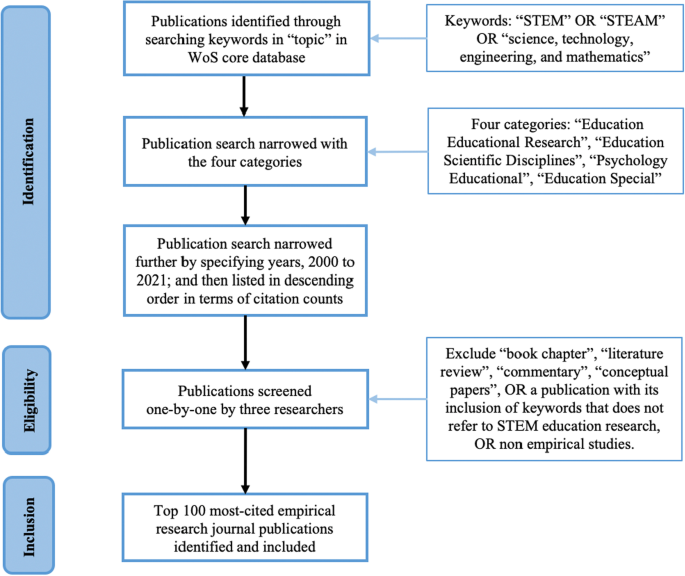
The formation of an academic field is evidenced by many factors, including the growth of relevant research articles and the increasing impact of highly cited publications. Building upon recent scoping reviews of journal publications in STEM education, this study aimed to provide a systematic review of high impact empirical studies in STEM education to gain insights into the development of STEM education research paradigms. Through a search of the Web of Science core database, we identified the top 100 most-cited empirical studies focusing on STEM education that were published in journals from 2000 to 2021 and examined them in terms of various aspects, including the journals where they were published, disciplinary content coverage, research topics and methods, and authorship’s nationality/region and profession. The results show that STEM education continues to gain more exposure and varied disciplinary content with an increasing number of high impact empirical studies published in journals in various STEM disciplines. High impact research articles were mainly authored by researchers in the West, especially the United States, and indicate possible “hot” topics within the broader field of STEM education. Our analysis also revealed the increased participation and contributions from researchers in diverse fields who are working to formulate research agendas in STEM education and the nature of STEM education scholarship.
Two recent reviews of research publications, the first examining articles in the International Journal of STEM Education (IJSTEM) and the second looking at an expanded scope of 36 journals, examined how scholarship in science, technology, engineering, and mathematics (STEM) education has developed over the years (Li et al., 2019, 2020a). Although these two reviews differed in multiple ways (e.g., the number of journals covered, the time period of article publications, and article selection), they shared the common purpose of providing an overview of the status and trends in STEM education research. The selection of journal publications in these two reviews thus emphasized the coverage and inclusion of all relevant publications but did not consider publication impact. Given that the development of a vibrant field depends not only on the number of research outputs and its growth over the years but also the existence and influence of some high impact research articles, here we aimed to identify and examine those high impact research publications in STEM education in this review.
Existing reviews of STEM education have provided valuable insights about STEM education scholarship development over the years. In addition to the two reviews mentioned above, there are many other research reviews on different aspects of STEM education. For example, Chomphuphra et al. (2019) reviewed 56 journal articles published from 2007 to 2017 covering three popular topics: innovation for STEM learning, professional development, and gender gap and career in STEM. They identified and selected these journal articles through searching the Scopus database and two additional journals in STEM education that were not indexed in Scopus at that time. Several other reviews have been conducted and published with a focus on specific topics, such as the assessment of the learning assistant model (Barrasso & Spilios, 2021), STEM education in early childhood (Wan et al., 2021), and research on individuals' STEM identity (Simpson & Bouhafa, 2020). All of these reviews helped in summarizing and synthesizing what we can learn from research on different topics related to STEM education.
Given the on-going rapid expansion of interest in STEM education, the number of research reviews in STEM education research has also been growing rapidly over the years. For example, there were only one or two research reviews published yearly in IJSTEM just a few years ago (Li, 2019). However, the situation started to change quickly over the past several years (Li & Xiao, 2022). Table 1 provides a summary list of research reviews published in IJSTEM in 2020 and 2021. The journal published a total of five research reviews in 2020 (8%, out of 59 publications), which then increased to seven in 2021 (12%, out of 59 publications).

The search returned 9275 publications under “Education Educational Research,” 2161 under “Education Scientific Disciplines,” 247 under “Psychology Educational,” and 15 under “Education Special.” The combined list of all publications was then placed in descending order in terms of citation counts up to the search date of Sept. 12, 2022, and each publication record was screened one-by-one by three researchers using the inclusion or exclusion criteria (see Table 2). At times when the publication record listed was not detailed enough, we searched and obtained the full article to screen and check to determine its eligibility. The process ended after identifying and selecting the top 100 most-cited empirical research journal publications.
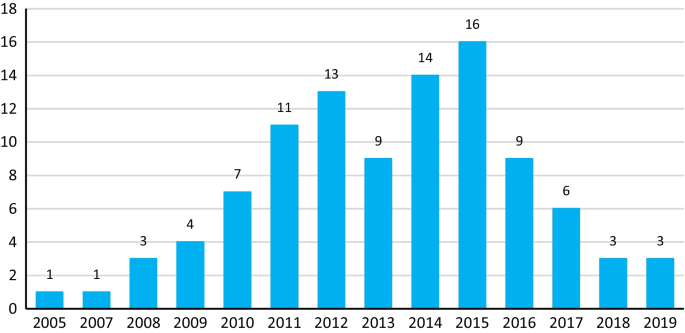
To have a more fine-grained sense of these highly cited research articles, we took a more detailed look at the top ten most-cited publications from the search (see Table 3). These ten most-cited publications were published between 2005 and 2014, with an average of 337 citations and a range of 238–820 citations per article. Only two of the top ten articles were published before 2010; both gained very impressive citations over the years (820 citations for the article published in 2009 and 289 citations for the other published in 2005). The on-going high citations of these two research articles are clear indication of their impact and importance in the field.
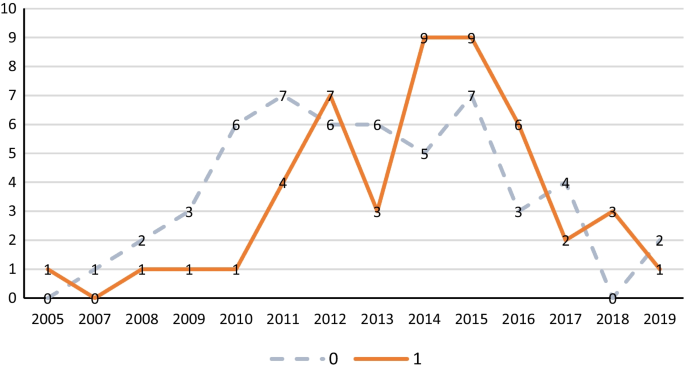
As a further examination of the distribution of publications in journals specified with STEM discipline(s), Fig. 4 shows the distributions of these highly cited articles in different journal categories over the years. It is clear that these highly cited articles were typically published in journals on general educational research or educational psychology before 2014. However, things started to change since 2014, with these highly cited articles published in more diverse journals including those with STEM discipline(s) specified in the journal titles. The journals that include only a single discipline of STEM have been more popular than others among those journals that specify one or more STEM disciplines. The result is not surprising as journals specified with a single discipline of STEM are more common, often with a long publishing history and support from well-established professional societies of education on a single discipline of STEM. This trend suggests that the importance of STEM education has also gained increasing recognition from professional societies that used to focus on a single discipline of STEM.
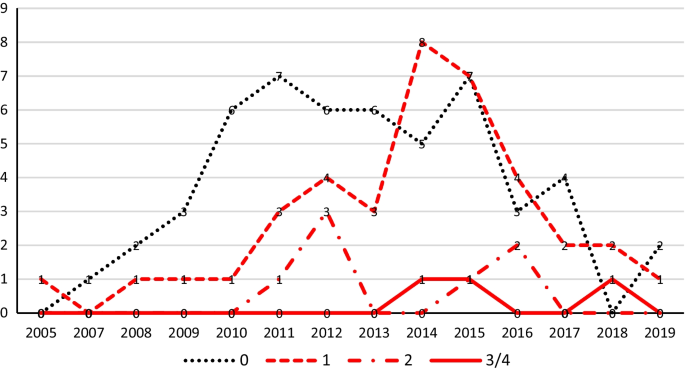
To glimpse into those recent changes, we took a closer look at the six articles published in 2018 and 2019 as examples (see Table 5). All of these articles have been highly cited in just 3 or 4 years, with an average of 102 citations (range, 75–144) per article. Across these six articles, the majority were published in journals whose titles specified one or more STEM disciplines: three in journals with a single discipline of STEM specified, one in a journal on STEM education, and two in journals on general educational research. At the same time, these recent publications are not specifically on any single discipline of STEM, but multi- and interdisciplinary STEM education.

Table 6 presents the distribution of all 100 highly cited publications classified in terms of the seven topic categories (TCs) over the years. Overall, all seven TCs have publications that were on the top 100 high citation publication list. There were clearly the most publications on TC6 (culture, social, and gender issues in STEM education), followed by publications on TC4 (STEM learner, learning, and learning environments at post-secondary level). The large number of publications with high citations in these two categories suggest possible evolution of research interests and topics in the field of STEM education. Taking a closer look at the six recent publications in Table 5, it is clear that culture, social, and gender issues were the focus in these recent publications, with the exception of one publication on assessment. This result presents a picture that appears somewhat different from what we learned from previous research reviews that did not focus exclusively on high impact publications from the WoS database (Li & Xiao, 2022; Li et al., 2020a).
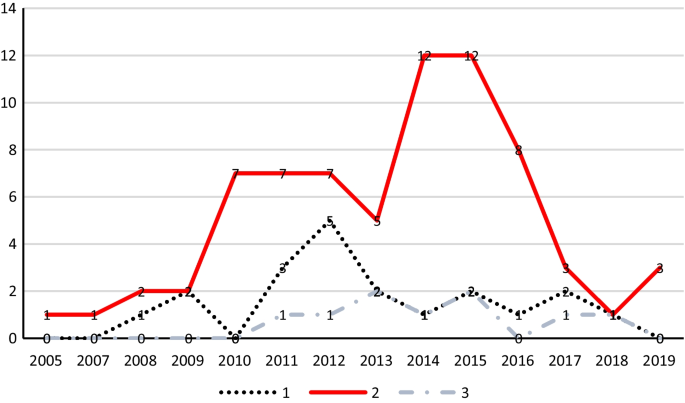
Corresponding author’s nationality/region and profession
Examining the corresponding author’s nationality/region helps reveal the international diversity in research engagement and scholarly contribution to STEM education. Figure 7 indicates 87 highly cited publications (87%, out of 100 publications) with the corresponding author from the United States, followed by 6 publications (6%) contributed by researchers in the U.K., and the remaining 7 publications with the corresponding author from seven other countries/regions (i.e., one publication for each country/region). The results show some international diversity in terms of the number of country/region represented, but with a clear dominance of research contributions from the West especially the United States. The result echoes what we learned above about the corresponding author’s nationality/region for the top ten most-cited articles (see Table 3).
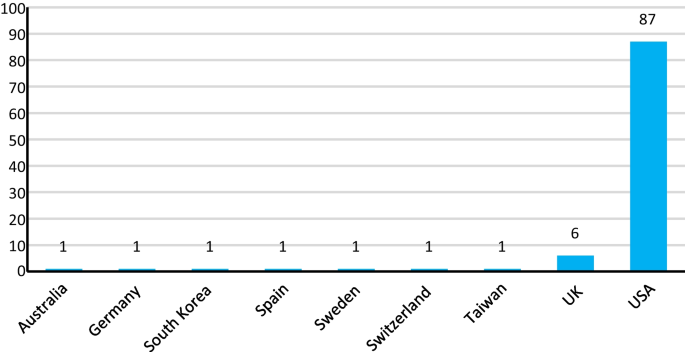
Recent reviews of journal publications in IJSTEM suggest a trend of increasing diversity in research contributions from many more different countries/regions (Li, 2022; Li & Xiao, 2022). We would not be surprised if the list of top 100 most-cited empirical research publications contained more contributions from other countries/regions in the future.
After coding the corresponding author’s profession in these top 100 articles, we found that similar numbers of publications had corresponding authors who were researchers in education (49) and STEM+ (51). This result is consistent with what we learned from the corresponding authors’ profession distribution in recent publications in IJSTEM (Li, 2022). The diversity in contributing to STEM education scholarship from researchers with various disciplinary training is evident.
To examine possible trends in the corresponding authors’ profession over time, Fig. 8 shows the distributions of these publications in the two profession categories over the years. It is interesting to note that researchers in education typically served as the corresponding authors for more articles published before 2014: 31 articles by researchers in education and 18 articles by researchers in STEM+ for a total of 49 published before 2014. However, a new trend has emerged since 2014, with many more researchers in STEM+ serving as the corresponding authors for these highly cited research articles: 18 articles by researchers in education and 33 articles by researchers in STEM+ for a total of 51 published since 2014.
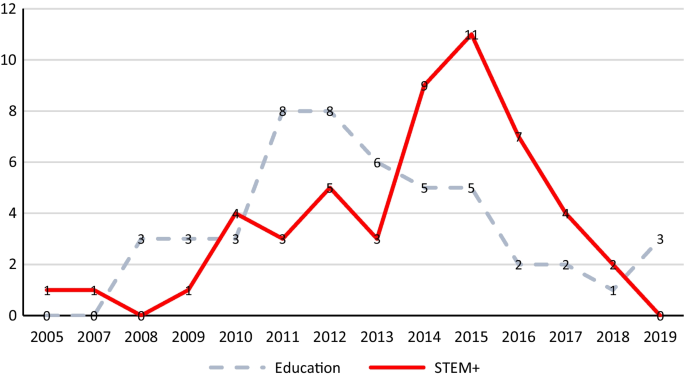
This trend is consistent with what we learned above about the increased number of these publications in journals specified with STEM discipline(s) since 2014 (see Figs. 3 and 4). We see an increasing number of researchers in STEM+ fields contributing and publishing empirical research articles in many journals associated with STEM discipline(s) since 2014, resulted in an increase in citations from professional communities while furthering the development of STEM education scholarship. The result is also consistent with what we learned from the authorship development of publications in IJSTEM over the years (Li & Xiao, 2022), an increasing trend of having STEM education scholarship contributions from diverse STEM+ fields.
With an increasing trend of contributions from researchers in diverse STEM+ fields, the identification of school level can help reveal where these high impact research publications focus on issues in STEM education. The coding results show that the majority (63) of these 100 most-cited articles focused on issues at the postsecondary level, 30 articles on issues at the K-12 school level, and 7 articles in the category of “general.”
Figure 9 presents the distributions of these highly cited publications across these three school categories over the years. It is interesting to note that high impact publications on issues at the postsecondary level outnumbered those in other two categories in almost every of these publishing years. As educational issues in K-12 school level were typically attended to by researchers in education, the increasing number of contributions from researchers in diverse STEM+ fields likely pushed the number of citations on publications that fit their interests more at the postsecondary level. The result is consistent with a growing trend in IJSTEM publications on STEM education at the post-secondary level revealed in a recent review (Li & Xiao, 2022).

We also noticed that almost no articles in the category of “general” before 2011 and after 2015 made to the list of top 100 most-cited publications. This result suggests that high impact empirical research in STEM education was conducted more at the school level rather than on issues across the boundary of K-12 school and college. With an increasing number of publications in the “general” category noted in recent review of IJSTEM publications (Li & Xiao, 2022), it would be interesting to learn more about cross-school boundary development of STEM education scholarship in the future.
This systematic review of high impact empirical studies in STEM education explores the top 100 most-cited research articles from the WoS database as published in journals from 2000 to 2021. These articles were published in a wide range of 45 reputable and well-established journals, typically with a long publishing history. These publications present an overall emphasis more on multi- and interdisciplinary STEM education rather than a single discipline of STEM, with an increasing trend of publishing in journals whose title specified one or more STEM discipline(s). Before 2014, 37% (18 out of 49) of these most-cited articles were published in journals whose title specified with a STEM discipline(s). In contrast, 59% (30 out of 51) articles were published in such journals since 2014, and even more so with 67% of the six articles published in 2018 and 2019. This trend is further elevated with two of those high impact articles recently published in this journal, International Journal of STEM Education. There appears a growing sense of developing disciplinary content consciousness and identity in STEM education.
Consistent with our previous reviews (Li et al., 2019, 2020a), the vast majority of these highly cited STEM research publications were contributed by authors from the West, especially the United States where STEM and STEAM education originated. Although there were contributions from eight other countries/regions in these top 100 publications, the diversity of international engagement and contribution was limited. Our results also provide an explanation of what may become “hot” topics among these highly cited articles. In particular, the topic of “culture, social, and gender issues in STEM education” is quite prevalent among those highly cited research publications, followed by the topic area of “STEM learner, learning, and learning environments at post-secondary level.” In comparison, topics related to disciplinary content integration in STEM teaching and learning and STEM teacher training have not yet emerged as “hot” among these highly cited empirical studies. Given that an increasing trend of diversity was noted from a review of recent publications in IJSTEM (Li, 2022), we would not be surprised if there will be more high impact research publications contributed by researchers from many other countries/regions on diverse topics in the future.
As STEM education does not have a long history, there will be many challenges and opportunities for new development in STEM education. One important dimension is research method. Among the top 100 most-cited empirical studies, quantitative methods were used as the dominant approach, followed by qualitative methods and then mixed methods. This is not surprising as research in multidisciplinary STEM education may require the use and analysis of data across different disciplines, more frequently in large quantitative data than in other data formats. However, when research questions evolve in the future, it would be interesting to learn more about method development and use in STEM education as a new research paradigm.
We started this review with the intention of gaining insights into the development of STEM education scholarship beyond what we learned about publication growth in STEM education from prior reviews. Indeed, this systematic review provided us with the opportunity to learn about possible trends and gaps in different aspects as discussed above. At the same time, we can learn even more by making connections across these different aspects. One important question in STEM education is to understand the nature of STEM education scholarship and to find ways of developing STEM education scholarship. However, STEM is not a discipline by itself, which suggests possible fundamental differences between STEM education scholarship and scholarship typically defined and classified for a single discipline of STEM. With the increasing participation and contributions from researchers in diverse STEM+ fields as we learned from this review, there is a good possibility that the nature of STEM education scholarship will be collectively formulated with numerous contributions from diverse scholars. Continuing analyses of high impact publications is an important and interesting topic that can yield more insights in the years to come.
The data and materials used and analyzed for the report were obtained through searching the Web of Science database, and related journal information are available directly from these journals’ websites.
Our analysis found that the vast majority (94%) of these top 100 articles had the same researcher to serve as the first author and the corresponding author. There are 10 articles that had more than one corresponding authors, and we chose the first corresponding author as listed in our coding.
Association for computing machinery AERA
American Educational Research Association
Cell biology education
Emerging Sources Citation Index
Institute of electrical and electronics engineers
International Journal of STEM Education
National Research Council
Social Sciences Citation Index
Science, technology, engineering, and mathematics
Disciplines or fields other than education, including those commonly considered under the STEM umbrella plus some others
Science, technology, engineering, arts, and mathematics
The author would like to thank Marius Jung and the staff at SpringerOpen for their support in publishing this article.
This work was supported by National Social Science Foundation of China, BHA180134.